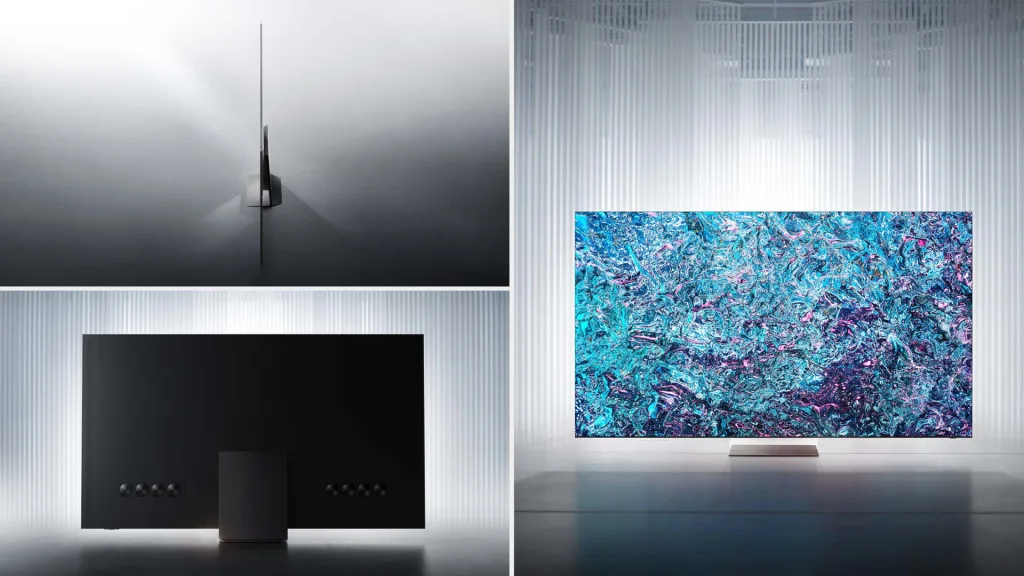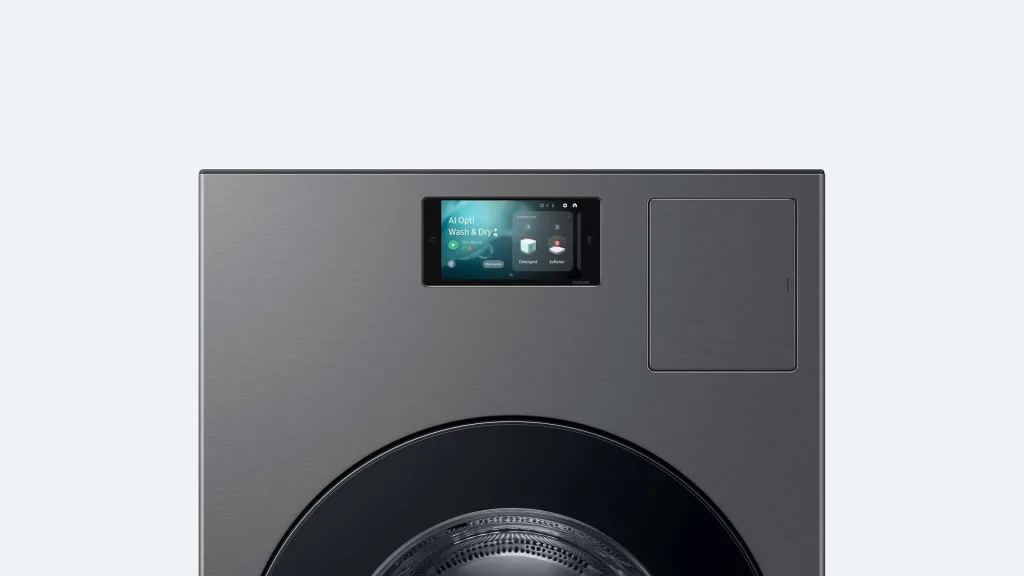- | 8:00 am
What you still don’t get about Samsung design
The Korean tech giant is playing a longer-tail game than most of us could ever realize.

I never really got Samsung until I was sitting in its R&D center just outside Seoul. Inside this glass-and-concrete monolith sits a beautiful, three-story design library finished entirely in natural oak. It felt like an architectural representation of Samsung—a mix of the ancient and the near future.
Compared to the buildings I’ve frequented at Google or Microsoft—office parks erected during the breathless dotcom expansion—Samsung’s headquarters are decidedly steadfast.
It’s the building that prepares me for what I hear from the design team, an idea that’s echoing in my brain half a year later: “Samsung is a thousand-year company.” So what if it started by selling dried fish and noodles in 1938 before selling its first black-and-white TV in 1969. The vision now is to be the human-centered cultural standard—not just for Korea, where it represents an oft-estimated 20% of the country’s gross domestic product—but the wider world.
Many of us perceive Samsung as a faceless electronics company. But it’s born from a culture of historical design intentionality that simply doesn’t exist in America. And it’s operating with an incredible confidence that it will lead culture through design for generations to come.
Samsung certainly isn’t there yet; the company faces immediate challenges to actualizing that vision. Apple’s iMessage has thwarted Samsung’s conquest of the U.S. smartphone market. And the company is filled with all the same corporate politics, lawsuits, and sometimes nonsensical priorities of any large corporation. But Samsung is not a business of unicorns and fail fasters. Employees are stewards to a larger, longitudinal ideal, cognizant that they are all the future’s history.

Six months after meeting Samsung’s design team in Seoul, I found myself in Milan visiting the Leonardo da Vinci Museum, where Samsung constructed an interactive installation for Milan Design Week. The installation was created to articulate the company’s new design philosophy as it looked toward 2030: “Essential, Innovative, Harmonious.”
“Essential design is about capturing the core value and expressing it in a simple, refined way,” explained Yoojin Hong, Samsung’s EVP and head of the user experience team, as we sat around a conference table near the glowing exhibit. Innovation is about adapting to consumer trends and standing out through new capability (their example? a Samsung Fold smartphone). And harmonious is about blending into a user’s space (like the Samsung Frame TV or speaker).
“We want to move beyond just providing the technology itself,” says Chul-yong Cho, VP and head of the design team for Samsung visual displays. “We want our products to be . . . embedded with the consumer’s space to provide meaning.”

The three words are meant to address both Samsung’s biggest strength and weakness: its gargantuan purview. The company has been the world’s largest smartphone maker for more than a decade (save for a single quarter), and the world’s largest TV manufacturer for nearly two. It’s also the top home appliance maker in the U.S., building everything from refrigerators to a robot shaped like a ball. Specialized arms of the company also build container ships and sell insurance. More than 1,500 designers in seven major cities across the globe work within subspecialities to build vastly different products that all point toward a single common UX and industrial design.
“Samsung makes everything. And that’s the coolest thing about Samsung. But at the same time, it’s one of the difficult things about Samsung,” says Hubert Lee, EVP of the design team for mobile eXperience (MX). “In a perfect world, it would be awesome to apply one constant, one aesthetic to everything we have, right? But in reality, it’s a bit difficult.”
In lieu of a singular vision connecting it all, Lee, alongside his colleagues, walked me through Samsung’s future vision for some of its biggest categories: appliances, televisions, and mobile devices. As it turns out, they do have a plan to connect them all after all.

APPLIANCES THAT ALREADY KNOW WHAT YOU’RE ABOUT TO DO
For the past several years, Samsung has distinguished many of its appliances through beauty, with projects like its Rothko-esque Bespoke refrigerators. However, Junho Yang, EVP and head of the design team for Samsung digital appliances, sees much of the white space in appliances to be about the intelligence inside. “Before it was more hardware-centric, and now it’s more software-centric,” he says, noting that Samsung is investing more in its software team to support this shift.

“I think when you look at all our [appliances], the users are using these products in very different environments; each of the consumers has different behaviors and different habits. And so it’s very hard to actually create a product that is used in only one setting or one type of condition,” Yang says. “So what is happening is the digital appliances or the products are actually learning . . . and fitting themselves to the user’s behavior and habits.”
He points to a few examples, powered by sensors and artificial intelligence: Samsung washers that can auto detect garments to choose the correct mode, or, more compellingly, refrigerators that learn when you tend to open and close them to ultimately save energy. While there’s still a fussy front-end dashboard that broadcasts some of this, Yang paints the picture of a quieter, adaptive response to human behavior that brings a tangible benefit to the user—even if they don’t always notice.

TVS THAT AREN’T STATIC BLACK BOXES
TVs and other screens represent some of the best technology available; their images are increasingly indistinguishable from reality. And every year, the cost per square inch of screen trends downward.
Every home is a home theater today—for better and worse. “Picture quality is getting better and better. TV screens are getting larger and larger,” says Cho. “But when you’re not watching the TV, it’s turned off, and basically sitting as a black box. So we don’t want the screens just to get larger, we want them to actually convey meaning.”

Samsung has addressed the phenomenon so far with Frame TVs that display art when they’re turned off, and its new speaker, which is basically a framed picture on your wall. The company intends to keep pushing beyond engineering sharpness and color into displays, and actually baking them into your home even more seamlessly. In many ways, this mentality follows the trends we’ve seen in the past few years with flexible, mobile office furniture becoming a more domestic phenomenon.
“After the pandemic, there’s a lot of change in the sort of home environment,” Cho says. “So we don’t want to just be, you know, stuck to the fixed screen. We want to look at different form factors.”
Cho teases how refreshing it would be to easily carry your screen of choice from room to room, or how Samsung is studying advanced projection technology that could disappear into the environment while also breaking out of the black box.

GALAXY SMARTPHONES AND NEW DEVICES THAT DREAM IN AI
Since the rise of touchscreens, hardware has been waiting on software. But then smartphones hit a wall, and generative AI appeared more or less overnight. Suddenly, software felt like it was waiting on new hardware.
“I think there is going to be a big hardware shift coming soon,” says Lee, who leads design on Galaxy devices. “It has to, because the way we use things is changing, right? Because of AI.”
While Humane and Rabbit have both botched their AI hardware launches this year, Samsung confirms it’s working full steam ahead on hardware for AI specifically. Lee says the biggest challenge to his mobile team now is in line with every one of Samsung’s competitors.
“How do we implement AI? How do we enhance it even more than what we have today?” he muses. “I’m sure every brand—every mobile brand—is going to be thinking about this, right? What is the future? What is so special about Samsung AI? And how can we differentiate from the others—if we can differentiate?”
To answer this question, Samsung is starting with human factors. Today, the company’s UX team optimizes features on its phone by measuring the speed of doing everyday tasks. And the design team says many of its camera features are already driven by AI toward this end—ranging from exposure to beautification filters—responding to what it hears people want to do and enabling them to make adjustments faster. Such Galaxy AI features will grow over time in ways you would expect: embracing someone’s personal tastes and preferences.
However, with the new wave of generative AI, the boundless possibility means the team needs to operate with even more restraint in considering how the technology can actually offer tangible benefit to someone. “You need a purpose,” Lee says. That purpose will determine the form, but Lee confirms Samsung is looking at wearables and other hardware to tap the potential of AI.
“So who knows, in the future? Maybe we don’t need this form,” he says, gesturing to his phone. “Just throwing it out there.”

ULTIMATELY, SAMSUNG IS BANKING ON AI AS MUCH AS YOU’D EXPECT
Samsung is impossibly large. It makes almost too many products to comprehend, and too many to dream of connecting them seamlessly. But the company’s designers argue, if anything could make the task possible, it would be AI. “I think this will be one of those years we’re seeing huge advancements in AI technology and related products,” Yang says. “And you’ll see all of the different divisions introducing new [AI] technology and products into the market.”
Hong argues that when you have AI-infused TVs, fridges, phones, and other products all manufactured by the same company, then you can get away with connecting them without the typical headaches we’ve known for years: extra smart home consoles and hardware connections—you know, all those extra costs and cognitive-load headaches that made the whole Internet of Things more work than it was worth. “All the existing [Samsung] devices can work together, based on AI,” she says.
“I think that’s where Samsung has an upper hand,” Lee adds later. “We have so many products that we can holistically combine them and have this immersive experience together.”
Maybe that sounds like an unrealistic plan for 2025 or even 2030. But when proposed by a thousand-year company? Anything else would sound downright unambitious.





































